Even though a transport chair is generally used for short trips and not for everyday use, there is a multitude of options for wheelchair users to choose from.
Don’t fall for the common misconception that they’re all simple. There are important factors to consider for your budget and lifestyle.
We provide an in-depth guide on buying a transport wheelchair, so you can feel confident in your decision. Let’s get rolling!
What is a Transport Chair?
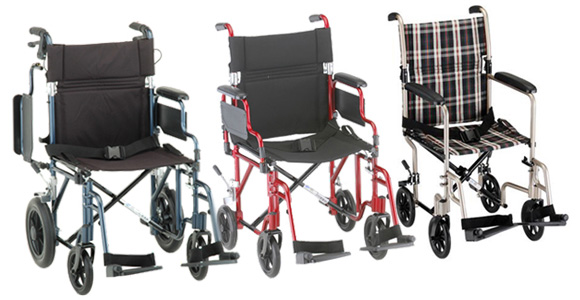
A transport wheelchair is a lightweight mobility device distinguished by a narrow build, small wheels, and a foldable design (for most models).
This type of wheelchair is designed to be pushed by a caregiver since its smaller wheels aren’t meant to be propelled forward by the user’s hands.
In other words, this isn’t your everyday wheelchair for accomplishing pertinent tasks.
The transport chair is there for additional support for those who tire easily while running errands, traveling, or recovering from a surgery/injury.
You’ll typically see these chairs in airports and hospitals, available to help a person travel across a short distance with less physical strain.
Who Should Purchase a Lightweight Transport Chair?
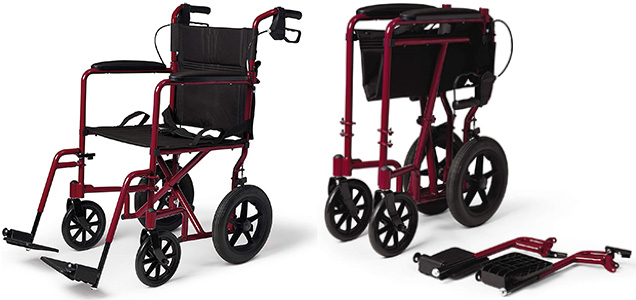
A portable transport chair has a specific use, and if you already have a conventional wheelchair then you might not need actually need one.
Remember, it’s there for extra support. If you’re huffing and puffing after walking a short distance, then a transport chair might come in handy to help you feel comfortable.
However, you do need a helping hand to push the transport chair, which is not always available for everyone.
In that case, this model is beneficial for people who aren’t able to propel themselves and always have a caretaker to assist them. Otherwise, you might be better off with a regular wheelchair.
Important Factors to Consider When Choosing a Lightweight Transport Wheelchair
Before you go falling in love with the first light transport wheelchair you see, bear in mind that this is a medical device that requires careful consideration to benefit your health.
In other words, what do you prioritize when buying a transport wheelchair? Perhaps it’s comfort or portability. Or you’re looking for a folding transport chair that can easily be stored if you live in a small apartment.
Transport chairs come with various accessories and components that appeal to different user goals. Be clear about your goals, and that will help you to narrow down the choices.
1. Weight & Width
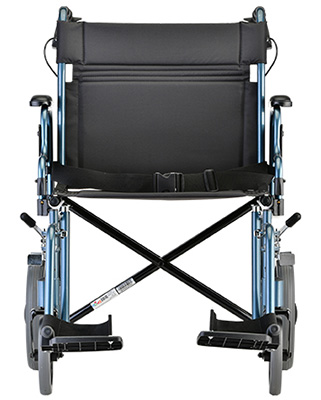
Let’s start with the various sizes and weights of transport chairs, as this is one characteristic that needs to be closely heeded for maximum comfort.
First, consider how often you’ll be lifting the chair and if there are extra features you’d like to add.
If you plan on using it for travel where you’ll need to fold it up and store it in the trunk of a car or airplane, then an ultra-lightweight transport wheelchair that weighs 19 lbs or less might be your ideal choice.
Now as mentioned, this is a great travel companion, but if you’re planning on transport chair accessories then the weight of the chair increases to around 25 lbs.
This isn’t a huge jump from the lightest transport chair weight, so it comes down to your strength, weight, and whether you’ll have a caretaker to help you while you travel.
Regarding width, a narrow transport chair is only a scant couple of inches wider than the seat cushion compared to manual wheelchair models that are 8 inches wider to accommodate larger wheels.
One advantage of a narrow transport wheelchair is that it can easily fit through doorways and tight spaces that are a challenge for traditional wheelchairs. This makes it a champ at careening through crowded airports and airplane aisles.
It’s also helpful for when staying in a hotel or vacation rental, where it can be difficult to find wheelchair-friendly bathrooms or bedrooms where space is limited.
2. How to Measure a Folding Transport Wheelchair
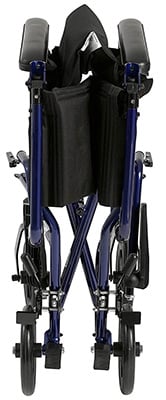
There are a few different measurements you can take to determine the best size transport chair for maneuverability and comfort.
Typically there are three seat width sizes:
- Narrow: 16” to 17”
- Medium: 18” to 20”
- Wide: 22”+
To find your seat size, start by sitting on a flat surface and measuring the width of your rear, adding a couple of inches to the result for added wiggle room.
Don’t forget to consider your weight, as well. Pediatric transport chairs or narrow ultralight transport wheelchairs can support 120 lbs or less, while medium-sized chairs accommodate up to 300 lbs.
There are also heavy-duty transport wheelchairs that can carry between 300 and 500 lbs.
3. The Braking System
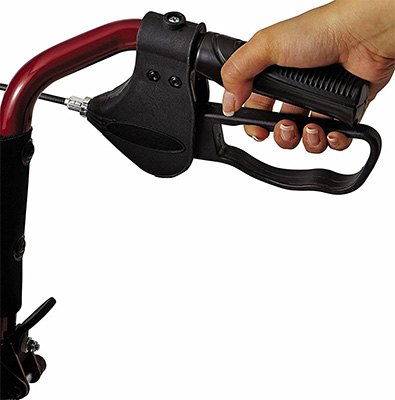
The next component you’ll want to consider with a patient transport chair is the braking system, as there are three different types to choose from.
The brakes are either located on the rear wheels, handlebars (handbrakes), or there can be a combination of both.
Your brake choice widely depends on where you’ll be using it.
Handbrakes are easier to access for the person pushing the wheelchair, while rear wheel brakes can be accessed by a caretaker or the wheelchair user.
Having a combination of both is ideal for more flexibility with how to brake in any given situation, especially if the chair is traveling over a slope or on uneven terrain.
4. Size of the Wheels
This depends mainly on how you plan to use the chair. If you’re traveling outdoors frequently, a chair with larger 12” wheels can tackle uneven terrain more smoothly.
However, if you’re planning to use it indoors on smooth surfaces, then 8” wheels should suffice.
5. Types of Leg Rests
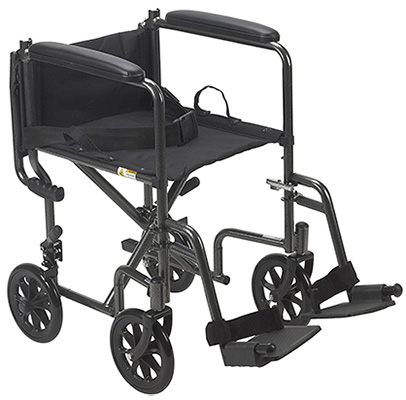
Most medical transport wheelchairs are equipped with swing-away leg rests that rotate to the sides for convenient entry and exit. This type of design is also easier to deal with if you’re only riding in the chair for short periods.
However, there is the option of elevating leg rests, which allow the user to position the leg rests at a raised angle for added comfort. It all comes down to your personal needs and how you plan to use the chair.
6. Materials
There are two primary materials for transport chairs, which affects the overall cost. Aluminum transport chairs are the pricier option, but it’s lightweight and easier to maneuver, making them the best option for travel.
Steel is less expensive but heavier than aluminum. While it might not bode well for travel, it’s stronger for carrying larger body types, as aluminum can’t handle large weight capacities.
Wheelchair Transport Chair Cost
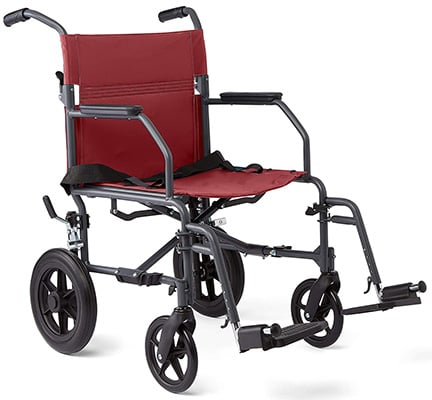
Finally, you’ll want to consider the cost of your transport chair, and luckily there are options to rent before going all-in on buying one.
Renting is a smart option if you only need the chair for short-term use, such as for a vacation or if you’re recovering from an injury or surgery.
Another perk of renting is that you won’t have to worry about maintenance and repairs, as the company handles this cost themselves.
But if you find that you’re hiring a rental chair more often than not, those payments quickly stack up. In this case, it might be time to purchase a transport chair of your own.
The average cost of a transport wheelchair is between $75 and $200.
If you do decide to purchase one, talk to your insurance provider to see if they’ll cover some of the cost. For example, Medicare may cover part of the cost of a transport chair, but only if it’s deemed medically necessary.
Final Thoughts on Buying a Transport Wheelchair
If you’re constantly on the road, taking a vacation that requires strenuous walking, or you’re recovering from an injury/surgery, then a transport chair is an essential mobility device designed to keep you comfortable.
Before buying a transport wheelchair, it’s imperative to ask yourself what you’ll be using it for and how often. This is a crucial deciding factor in choosing the best size, weight, and material for your needs.
You can also talk to your provider and they can recommend the best model for your lifestyle.
Resources & References: